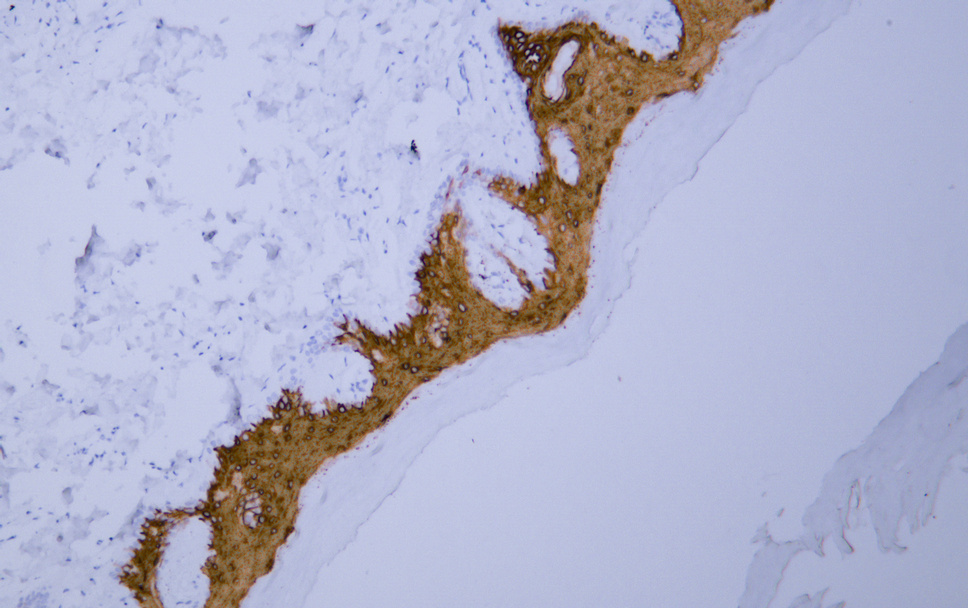Cytokeratin 10 (ABT056) IHC kit
- Catalog No.:IHCM6857
- Applications:IHC
- Reactivity:Human;
- Target:
- Cytokeratin 10
- Fields:
- >>Estrogen signaling pathway;>>Staphylococcus aureus infection
- Gene Name:
- KRT10 KPP
- Protein Name:
- Cytokeratin-10
- Human Gene Id:
- 3858
- Human Swiss Prot No:
- P13645
- Immunogen:
- Synthesized peptide derived from human CK10 AA range: 500-584
- Specificity:
- The antibody can specifically recognize human CK10 protein, and shows no cross reaction with CK4, 5, 6, 7, 8, 14, 15, 18, 19.
- Source:
- Mouse, Monoclonal/IgG1, kappa
- Purification:
- The antibody was affinity-purified from ascites by affinity-chromatography using specific immunogen.
- Storage Stability:
- 2°C to 8°C/1 year
- Other Name:
- Keratin, type I cytoskeletal 10 (Cytokeratin-10;CK-10;Keratin-10;K10)
- Background:
- This gene encodes a member of the type I (acidic) cytokeratin family, which belongs to the superfamily of intermediate filament (IF) proteins. Keratins are heteropolymeric structural proteins which form the intermediate filament. These filaments, along with actin microfilaments and microtubules, compose the cytoskeleton of epithelial cells. Mutations in this gene are associated with epidermolytic hyperkeratosis. This gene is located within a cluster of keratin family members on chromosome 17q21. [provided by RefSeq, Jul 2008],
- Function:
- disease:Defects in KRT10 are a cause of bullous congenital ichthyosiform erythroderma (BCIE) [MIM:113800]; also known as epidermolytic hyperkeratosis (EHK) or bullous erythroderma ichthyosiformis congenita of Brocq. BCIE is an autosomal dominant skin disorder characterized by widespread blistering and an ichthyotic erythroderma at birth that persist into adulthood. Histologically there is a diffuse epidermolytic degeneration in the lower spinous layer of the epidermis. Within a few weeks from birth, erythroderma and blister formation diminish and hyperkeratoses develop.,disease:Defects in KRT10 are a cause of epidermal nevus epidermolytic hyperkeratotic type [MIM:600648]. Epidermal nevi affect about 1 in 1,000 people. They appear at or shortly after birth as localized lines of epidermal thickening. The extent of skin involvement varies widely.,disease:Defects in KRT10 are a cause of icht
- Subcellular Location:
- Cytoplasmic, Membranous
- Expression:
- Seen in all suprabasal cell layers including stratum corneum. Expressed on the surface of lung cell lines (PubMed:19627498).
- June 19-2018
- WESTERN IMMUNOBLOTTING PROTOCOL
- June 19-2018
- IMMUNOHISTOCHEMISTRY-PARAFFIN PROTOCOL
- June 19-2018
- IMMUNOFLUORESCENCE PROTOCOL
- September 08-2020
- FLOW-CYTOMEYRT-PROTOCOL
- May 20-2022
- Cell-Based ELISA│解您多样本WB检测之困扰
- July 13-2018
- CELL-BASED-ELISA-PROTOCOL-FOR-ACETYL-PROTEIN
- July 13-2018
- CELL-BASED-ELISA-PROTOCOL-FOR-PHOSPHO-PROTEIN
- July 13-2018
- Antibody-FAQs
- Products Images

- Human cervix tissue was stained with Anti-Cytokeratin 10 (ABT056) Antibody

- Human skin tissue was stained with Anti-Cytokeratin 10 (ABT056) Antibody



